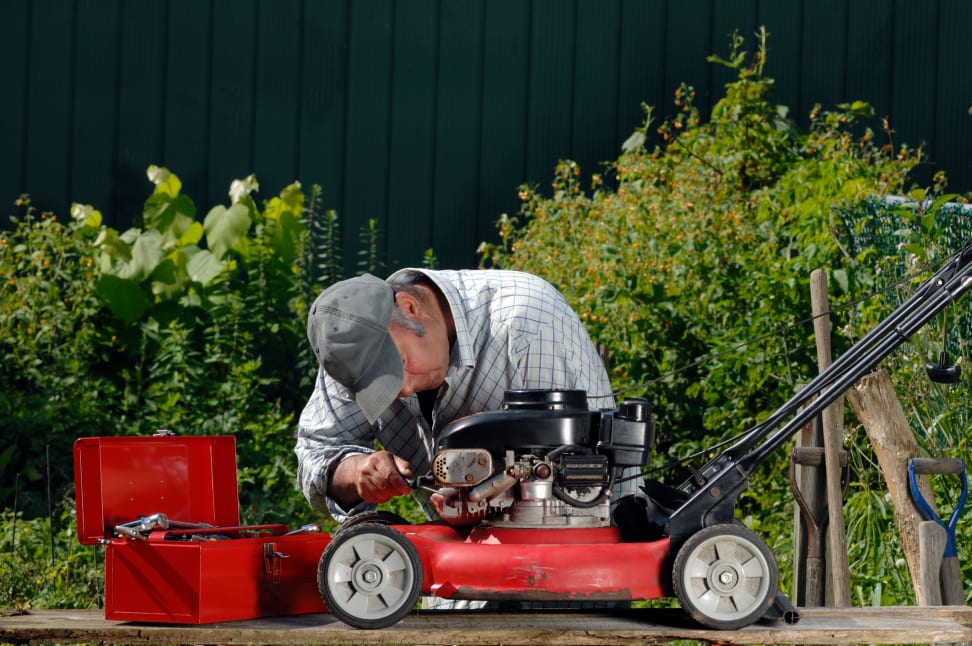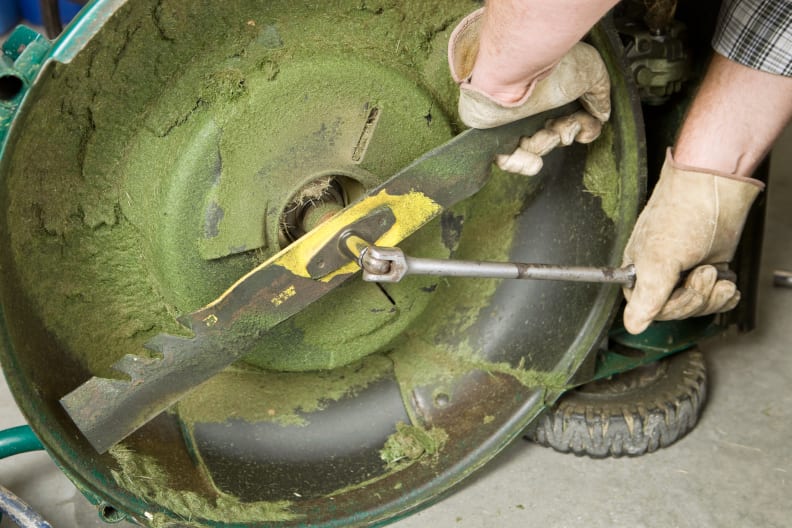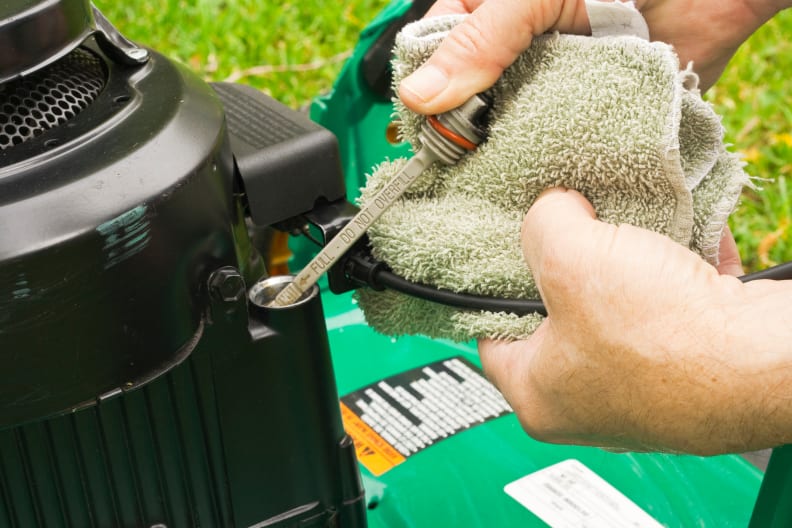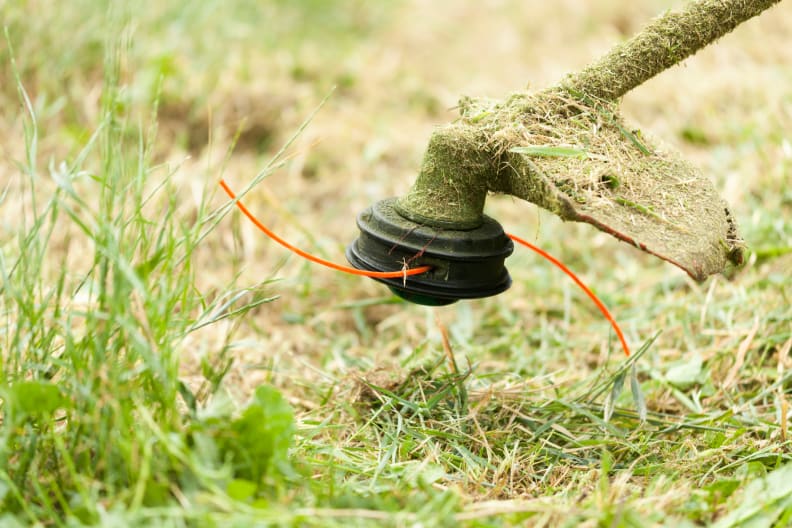Winter is the best time to repair your tools—here’s why
Make sure they're in good shape before you store them for winter.
 Credit: Fertnig
Credit: Fertnig
Recommendations are independently chosen by Reviewed’s editors. Purchases you make through our links may earn us a commission.
Now that it’s winter, and all the mowing and weeding for the year is done, it’s time to do all the tool maintenance you’ve been putting off since last spring. A little bit of indoor work on your outdoor tools can save you headaches and hassles when the growing season starts up again.
It’s not just about aesthetics. Tools that have been properly maintained work faster and handle easier to keep your yard looking great. Here’s how to get your lawnmower, pruners, loppers, trowels, and shovels ready for the spring.
Lawnmowers

Keep lawnmower blades sharp—either carefully deal with them yourself or consider calling a pro.
The number one winter chore for all lawnmower owners is sharpening the blades. Dull mower blades leave ragged edges that look messy and make your grass more vulnerable to disease and pests. You cansharpen your own lawnmower bladesorget them sharpenedat a hardware store.
Once you’ve gotten your lawnmower blade off, take a look at the rest of the lawnmower. Rust, water condensation, and old gas are the bane of lawnmowers. To prevent exterior rust, clean your lawnmower deck of any dried, stuck-on grass and debris. Use wooden shims to scrape off caked-on grass, then power-wash or use a hose on your mower. If you’ve put away your hose for the year, you can use wet rags. Let it dry thoroughly before storing.
While you’re cleaning your lawnmower deck, check for signs of mice. Small animals love to build nests in cozy lawnmowers. You may want to put mouse traps orpet-resistant bait stationsunder your lawnmower deck.

Checking the oil levels in a lawn mower is important to do every winter.
If you have an electric mower, remove the battery and keep it in a dry place where the temperature will stay between 40°F-80°F. You should check the battery periodically, andkeep it charged to 40%。如果你有一个汽油割草机,you should have either drained the fuel or added fuel stabilizer before the winter began. The ethanol in gas candissolve rubber and plasticin the fuel system, and the gas can gum up your carburetor
Didn’t remember to do that? You can stilldrain the old gasout of your lawnmower to prevent future damage. Then, you can either leave it empty for the season—if you think the air is going to stay dry until you fill the tank again—or fill your engine with new fuel andfuel stabilizer, and run the engine briefly to make sure the new fuel is distributed through your mower. Fuel stabilizer forms a protective layer on top of your gas to keep the gasoline from evaporating and water from getting into your engine.
Cool months are also a good time to drain the oil and replace the oil filter (make sure the engine is warm before you drain the oil) and replace your lawnmower’s air filter, fuel filter, and spark plug.
String trimmers, hedge trimmers, and blowers

String trimmer blades may need to be replaced, and winter is the perfect time to do it.
Most small gasoline-powered outdoor equipment likestring trimmers, weed eaters, weed whackers, hedge trimmers, and blowers with two-cycle engines need winter maintenance just like a lawnmower. The most important step for gas-powered equipment is to either empty the fuel tank, or add stabilizer—although if you’re using a two-cycle engine oil with stabilizer,you may not need toadd new stabilizer to the tank. If you’re using electric tools, store the battery in a warm, dry place.
After you’ve stabilized the fuel, or stored your battery, and change the oil (even electric string trimmers need lubrication), any replaceable air or fuel filters, and the spark plugs. If you’re using gas-powered equipment, clean the fuel filter.

Be sure to clean any debris off of your string trimmer before you store it for winter.
If your equipment has blades, check them.You can sharpenweed eater and hedge trimmer blades with a mill file or power grinder—smooth out chipswith a power grinder—or you can get them sharpened at a hardware store. If you have a string trimmer, change the trimmer line (string) if you haven’t checked it lately; it’s frustrating to take your string trimmer out in the spring, start it up, and immediately have the trimmer line string run out.
Lastly, clean off any lingering dirt and vegetation. You can use a degreaser to clean off dirt and consider lightly oiling exposed metal parts to keep them free or rust.
Pruners, pruning shears, secateurs, loppers, and clippers

Keep pruners sharp year round by sharpening their blades and keeping them clean.
First, clean your blades. Ideally, you should be cleaning them after every use, but everyone gets busy. Winter is a good time to get into better habits. Removing dirt and old bits of stems will reduce rust and wear, and keep your pruners from spreading diseases from plant to plant.
Wash your pruner’s blades with dish detergent and water and buff off any caked-on dirt or rust with a plastic scrubber or steel wool. If there’s sticky, dried resin from cutting pine trees or other evergreens, you can wipe it off with a rag soaked with a little paint thinner or lighter fluid. Wipe the blades with rubbing alcohol to remove any lingering disease microbes, and dry them thoroughly.
Then, sharpen your blades. sharp blades make the difference between easy cuts and broken, mangled branches. You can take them to a hardware store, orsharpen them at homewith a whetstone or a diamond file.
If you’re sharpening the blades at home, be careful to follow the bevel of the blade—the original angle it was ground in the factory. Some experts recommend running the blade down the whetstone in a straight line; others move the blade in a circle. It doesn’t matter as long as you maintain that beveled edge. When you’re done, you should be able to cut a piece of office paper cleanly. If the cut tears, go back and sharpen the blade more.
Afterward, wipe the blades and lubricate them with oil. Any oil will do, fromWD-40to canola oil—onegarden bloggeruses grapeseed oil.
If you’re lucky enough to own equipment that you can take apart, likeFelcoorARS pruners, winter is a great time to learn how to take them apart and replace the springs and gears.Replacement partsare widely available. Once you know how to replace the spring, you can keep your pruners working smoothly for years.
Trowels, shovels, spades, hoes, and mattocks

Even shovels need love in the winter.
最好的泥刀、铁锹和锄头穿过il, letting you plant in hard clay, and chop through pesky roots. Sooner or later, though, all these tools lose their edge and need to be sharpened. Winter is an excellent time to get your tools back in shape.
钢丝刷下班土块的泥土,然后wipe the tool clean with a rag, using a solvent like paint thinner or lighter fluid to remove stubborn resins. Remove any rust with steel wool or sandpaper. Dry it thoroughly.
Then, it’s time to sharpen the edge. Different tools need to be sharpened at different angles—here’sa good illustrationof what a typical wide sharpening angle for a shovel (30 to 35 degrees) looks like versus the more acute angle for sharpening pruning shears (10 to 20 degrees.) An8-inch mill fileis fine for sharpening shovels and other tools that get dulled by scraping on dirt and rocks. As always, following the existing angle/bevel of the blade.
One you’ve sharpened the blade, oil the blade and other metal surfaces lightly. If oil drips on the floor when you stand your shovel up, you’ve put on too much. If your tools have wooden handles, clean them and rub them with linseed oil to keep the wood from drying and cracking.
To keep your shovels and other blades sharp and clean between sharpenings, fill a five-gallon bucket about 80% with clean sand and mix in one quart of clean motor oil, linseed oil, or mineral oil. When you bring your tools in from working in the yard, you can either push them in and out of the oily sand a few times to clean them (wipe them off with a rag afterward)—or just store them in the bucket if you have the room. Your dry, rust-free tools will thank you.
Just remember: If you’re tired of scrubbing rust off your trowels and shovels, you can buystainless steel garden tools。They may be a little heavier than the classic tools, but they definitely won’t rust.





